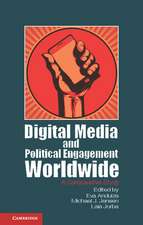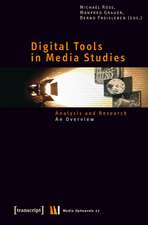Journalism, Science and Society: Science Communication between News and Public Relations: Routledge Studies in Science, Technology and Society
Editat de Martin W. Bauer, Massimiano Bucchien Limba Engleză Paperback – 18 mar 2010
The book takes three distinct perspectives on this interesting subject. Firstly, science journalists reflect on their ‘operating rules’ (science news values and news making routines). Secondly, a brief history of science journalism puts things into context, characterising the changing output of science writing in newspapers over time. Finally, the book invites several international journalists or communication scholars to comment on these observations thereby opening the global perspective.
This unique project will interest a range of readers including science communication students, media studies scholars, professionals working in science communication and journalists.
| Toate formatele și edițiile | Preț | Express |
|---|---|---|
| Paperback (1) | 440.69 lei 6-8 săpt. | |
| Taylor & Francis – 18 mar 2010 | 440.69 lei 6-8 săpt. | |
| Hardback (1) | 1112.34 lei 6-8 săpt. | |
| Taylor & Francis – 7 sep 2007 | 1112.34 lei 6-8 săpt. |
Din seria Routledge Studies in Science, Technology and Society
- 20%
 Preț: 241.24 lei
Preț: 241.24 lei -
 Preț: 303.87 lei
Preț: 303.87 lei -
 Preț: 309.84 lei
Preț: 309.84 lei -
 Preț: 312.02 lei
Preț: 312.02 lei -
 Preț: 354.53 lei
Preț: 354.53 lei -
 Preț: 232.32 lei
Preț: 232.32 lei -
 Preț: 378.92 lei
Preț: 378.92 lei - 18%
 Preț: 1110.74 lei
Preț: 1110.74 lei -
 Preț: 238.04 lei
Preț: 238.04 lei -
 Preț: 492.16 lei
Preț: 492.16 lei -
 Preț: 385.02 lei
Preț: 385.02 lei - 18%
 Preț: 1007.36 lei
Preț: 1007.36 lei -
 Preț: 431.35 lei
Preț: 431.35 lei -
 Preț: 350.72 lei
Preț: 350.72 lei - 18%
 Preț: 1055.51 lei
Preț: 1055.51 lei -
 Preț: 344.53 lei
Preț: 344.53 lei - 26%
 Preț: 762.57 lei
Preț: 762.57 lei -
 Preț: 349.91 lei
Preț: 349.91 lei - 18%
 Preț: 1059.14 lei
Preț: 1059.14 lei - 18%
 Preț: 1000.27 lei
Preț: 1000.27 lei - 20%
 Preț: 387.78 lei
Preț: 387.78 lei - 26%
 Preț: 764.20 lei
Preț: 764.20 lei - 18%
 Preț: 1056.35 lei
Preț: 1056.35 lei - 18%
 Preț: 1110.47 lei
Preț: 1110.47 lei -
 Preț: 498.91 lei
Preț: 498.91 lei - 18%
 Preț: 703.93 lei
Preț: 703.93 lei -
 Preț: 363.96 lei
Preț: 363.96 lei -
 Preț: 276.68 lei
Preț: 276.68 lei - 26%
 Preț: 820.71 lei
Preț: 820.71 lei - 18%
 Preț: 1053.92 lei
Preț: 1053.92 lei -
 Preț: 416.82 lei
Preț: 416.82 lei -
 Preț: 432.29 lei
Preț: 432.29 lei -
 Preț: 487.37 lei
Preț: 487.37 lei - 23%
 Preț: 321.72 lei
Preț: 321.72 lei - 26%
 Preț: 765.01 lei
Preț: 765.01 lei -
 Preț: 482.53 lei
Preț: 482.53 lei -
 Preț: 480.62 lei
Preț: 480.62 lei
Preț: 440.69 lei
Nou
Puncte Express: 661
Preț estimativ în valută:
84.32€ • 88.04$ • 69.79£
84.32€ • 88.04$ • 69.79£
Carte tipărită la comandă
Livrare economică 05-19 aprilie
Preluare comenzi: 021 569.72.76
Specificații
ISBN-13: 9780415881340
ISBN-10: 041588134X
Pagini: 300
Ilustrații: 14 black & white illustrations, 3 black & white halftones, 11 black & white line drawings
Dimensiuni: 152 x 229 x 16 mm
Greutate: 0.56 kg
Ediția:1
Editura: Taylor & Francis
Colecția Routledge
Seria Routledge Studies in Science, Technology and Society
Locul publicării:Oxford, United Kingdom
ISBN-10: 041588134X
Pagini: 300
Ilustrații: 14 black & white illustrations, 3 black & white halftones, 11 black & white line drawings
Dimensiuni: 152 x 229 x 16 mm
Greutate: 0.56 kg
Ediția:1
Editura: Taylor & Francis
Colecția Routledge
Seria Routledge Studies in Science, Technology and Society
Locul publicării:Oxford, United Kingdom
Public țintă
PostgraduateCuprins
1. Introduction Part 1: The Changing Scenarios of Science Communication 2. Insects or Neutrons?: Science News Values in Interwar Britain 3. The Rise and Fall of Science Communication in Late 19th Century Italy 4. From Journalism to Corporate Communication in Post-War Britain 5. Big Science, Little News: Science Coverage in the Italian Daily Press, 1947-1997 6. Growing, but Foreign Source Dependent: Science Coverage in Latin America 7. The Latest Boom in Popular Science Books Part 2: Science Writing: Practitioners’ Perspectives 8. Telling Stories, not Educating People 9. The Sex Appeal of Science News 10. Science Stories that cannot be Told 11. Chiara Palmerini: Science Reporting as Negotiation 12. Why Journalists Report Science as they do 13. How the Internet Changed Science Journalism 14. The End of Science Journalism Part 3: Public Relations for Science - Practitioners’ Perspectives 15. The Royal Society and the Debate on Climate Change 16. PR for Physics of Matter: Tops… and Flops 17. Communication by Scientists or Stars? 18. A PR Strategy Without a PR Office? 19. Public Engagement of Science in the Private Sector: A New Form of PR? 20. The Strength of PR and the Weakness of Science Journalism 21. The Use of Scientific Expertise for Political PR: The Donana and Prestige Cases in Spain Part 4: International Commentary 22. Sharon Dunwoody: USA - Focus on the Audience 23. Australia: Co-Ordination and Professionalisation 24. South Africa: Building Capacity 25. South Korea: The Scandal of Professor Hwang Woo-Suk 26. Japan: A Boom in Science News
Recenzii
'Recently published controversies concerning the dangers of global warming and its implications for public policy provide a background that makes this book's subject of considerable interest ... Topics include the question of what pressures are put on science journalists, the accuracy and depth of what they write, the educational role of science journalism, and how journalists see their role in society. International contributors provide views from other countries ... their varied points of view bring up many thought-provoking issues about the role of science journalism more generally in public education and public policy.' – Choice
Descriere
Analyzing the role of journalists in science communication, this book presents perspectives on how this field is going to evolve in the twenty-first century.













